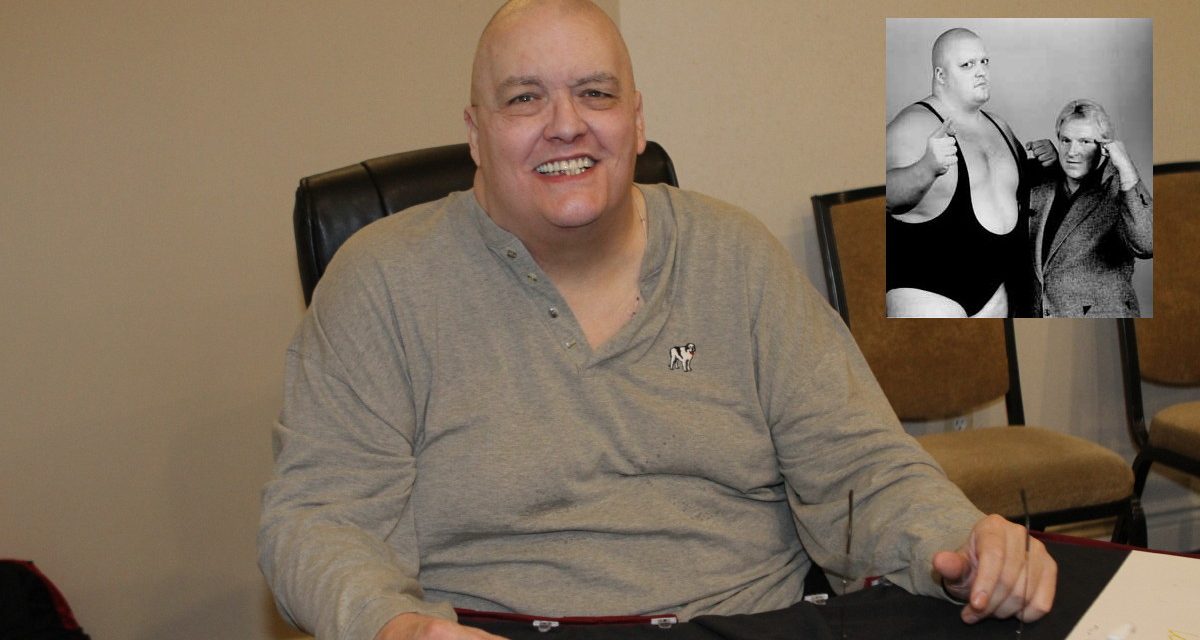King Kong Bundy, the monster villain that demanded a five-count from referee and who faced off against Hulk Hogan at WrestleMania 2, has died. He was 61.
The news was first reported by his long-time friend Dave Herro, a Milwaukee, Wisc.-based promoter, on Twitter. “Today we lost a Legend of a performer and someone that I considered family. @RealKKBundy Rest In Peace my friend. Thank you for believing in me. #KingKongBundy” WWE confirmed the news.
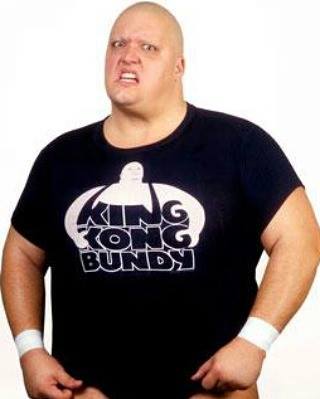
King Kong Bundy
Born Chris Pallies on November 7, 1957, in Atlantic City, New Jersey, he went to Washington Township High School in Sewell, New Jersey, graduating in 1974. One report has him as a District 30 and Region 8 heavyweight champion as a high school wrestler. Growing up, he once said that he enjoyed football, baseball and roller derby, but just “fell into being a professional wrestler.”
“How I got into wrestling was by a fluke,” Bundy explained in a 2003 interview with SLAM! Wrestling. “My brother was an elementary phys ed. teacher, and one of his students was the daughter of Dick Woehrle, who was a WWF referee. So my brother asked her if her father could get him some tickets to wrestling. Well somehow Dick got the message that my brother wanted to be a wrestler, picked up the phone book, and called me instead by mistake. I was around 23, just kind of drifting aimlessly at the time, and figured why not give it a shot.”
The 6-foot-4, 460-pound beast trained with Larry Sharpe in his home state, before Sharpe had opened the Monster Factory gym; the success early of Paillies as Chris Canyon and Chris Cannon helped put Sharpe on the mat as a trainer.
He was blessed with a sense of humour. In an interview with this writer, Bundy was asked about his debut. “1980, brother. I was just a baby. I had to get permission when I first started. I was in elementary school back then in 1980. I had to get permission to leave school for matches if they were more than a couple of miles away.” That those numbers don’t add up was part of his charm.
Early stardom came in the red-hot World Class Championship Wrestling territory, based out of Dallas, Texas, where he became King Kong Bundy, managed by Gary Hart. In 1982, at the Fritz Von Erich Retirement Show at Texas Stadium, Bundy did the honours for the retiring veteran.
In an interview with Phil Strum of the Poughkeepsie Journal in 1999, Bundy talked about the Von Erichs. “Very nice guys. Great guys to work with. They weren’t the type … you know. You could hit them as hard as you could and they wouldn’t complain because they were hitting you pretty hard too. Especially Kevin. He was stiff as a board. Oh man. Probably the best wrestler was David, who passed away. But they were all good guys.”
Following the run in WCCW, he worked in Memphis, Knoxville, and Mid-South Wrestling — where the gimmick demanding a five count from the referee began. “My idea. I got tired of people saying they didn’t get beat by King Kong Bundy. When I beat a man,” he said, “he knows he’s been beaten. He knows he’s been beaten by a better man, by a far better man.” Bundy also competed in Japan and Germany.
It all got him noticed by the expanding WWF. He got a monster push right from the start, beating SD Jones at the first WrestleMania in a reported nine seconds. “That felt good. I always thought it should be a second or two sooner,” he said, predicting the future (Kane later beat Chavo Guerrero Jr. quicker, in 2008), “because I think that record has been broken, hasn’t it?”
Initially managed by Jimmy Hart in WWF, it was under Bobby “The Brain” Heenan that “the walking condominium” hit the sport’s top level, in the main event of WrestleMania after first upsetting Hogan on Saturday’s Main Event. In a 1998 interview, he had nothing but good memories.
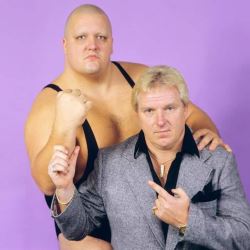
King Kong Bundy and Bobby Heenan.
“That [Saturday’s Main Event], and being in the main event of WrestleMania 2, I would say were career highlights. I’ve had so many, how can I rate them all, you know?” he said. He lost to Hogan in Los Angeles in the iconic big blue bar cage in the finale at Mania 2.
Bundy said that he and Hogan were “associates” rather than friends, but that he respected him immensely. “Hulk Hogan is wrestling, anybody who says anything but that, even though he was rated before Reckless Youth in this year’s PWI 500 — which I think everybody should boycott PWI for that reason. He is wrestling,” said Bundy in 1998.
Following Mania, Bundy began teaming with Big John Studd, continuing Studd’s feud with Andre the Giant. In one memorable moment, the big men double-teamed Andre during a bout in Toronto at Maple Leaf Gardens, and broke his ribs. “I remember the Giant was getting a little too big for his britches and Studd had already cut his hair. Remember he used to carry his hair around in a bag? I mean we cut his hair, broke his ribs, what else could we do to the man, know what I mean?” mused Bundy in 1998.
For all the success as a main event star, it was a comedy match that came up the most often. At WrestleMania 3, in Pontiac, Michigan, Bundy he teamed with midgets Lord Littlebrook and Little Tokyo against Hillbilly Jim, The Haiti Kid and Little Beaver. The full-sized wrestlers were only supposed to face each other, and the little people taking on the little people. Bundy instead took matters into his own hands. “Well, I remember Little Beaver popping me with that moccasin and that thing stung like a son-of-a-bitch. So I was a little hard on the Beaver that night, know what I mean? But he deserved it.” The visual of Bundy beating up the little person is as iconic as Hogan slamming Andre in the main event that year.
Bundy used his stardom in WWF for a little fame outside of the squared circle too. He did a campaign for IBM-clone computers, made appearances on TV and movies. Perhaps his most noted role was on Married … with Children where the Bundy family name had been inspired by King Kong Bundy, making him a natural for a couple cameos.
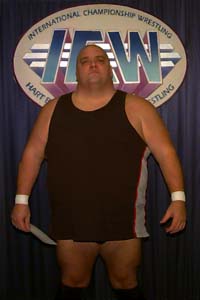
Bundy in 1998. Photo by Greg Oliver
By early 1988, Bundy was gone from WWF, and considered life beyond wrestling, getting divorced, opening a bar among other projects. He never really wrestled during that time period, until an out-of-nowhere appearance with ECW at November to Remember in 1993. He was asked about ECW in the 1998 interview. “I wrestled there one time when I first started back. Those boys are a little too extreme for me. Brother, it’s like everything else. If the money’s there, I’d be there. I mean, who’s going to beat me? That Chris Candido? He’s about as big as my leg. Taz? Like he’s going to give me one of those super-duper hurricane-o suplexes? I don’t think so, bro!”
Instead of ECW, Bundy returned to WWF, as a part of Ted DiBiase’s Million Dollar Corporation. His final WrestleMania was a loss to the Undertaker at WrestleMania 11. It was his last significant wrestling appearance. “Well, the situation it was in, it was bleak. I was with the Million Dollar Corporation, but you know, Ted DiBiase couldn’t manage his way out of a wet paper bag and he was keeping all the money,” Bundy said in 1998, playing to storyline, as he often did in interviews. “And the business at the time was on its ass anyway. I just figured it was time to leave and go out on my own.”
Bundy tried stand-up comedy for a bit, one of the early wrestlers in what became a bit of a trend, wrestlers doing one-man shows. Veteran wrestler Joe E. Legend posted online that Bundy “was as clever and witty as he was immense.”
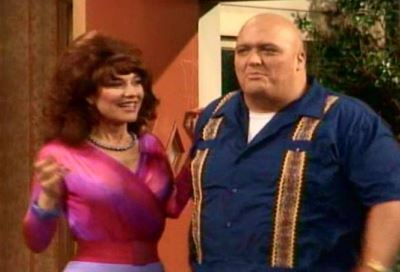
Peg Bundy and King Kong on Married … with Children.
On the independent circuit, Bundy could work when and where he wanted. He ended up mentoring wrestlers, like current Impact Wrestling VP Scott D’Amore, who posted his appreciation for Bundy. “He was such a big part of my childhood and then he became such a dear friend. I spent many a road trip ‘Sitting Under The Learning Tree with the Great Bundy,'” wrote D’Amore. ” They always say the easiest way to get over hero worship is to meet your hero. Well with Chris meeting him made him even more of a hero. I will never forget the lessons I learned from him and the laughs we shared. I’m not an emotional guy but I’m utterly crushed right now…”
New England Championship Wrestling promoter Sheldon Goldberg noted how Bundy worked the indy scene. “Back in the 90’s, Bundy was the king of independent wrestling, topping cards all over the country. If you wrestled indy shows in that period, you probably shared a locker room with him,” wrote Goldberg on Facebook. “Like the late Jimmy Snuka, there is a generation of wrestlers for whom Bundy was the first big star they were on a card with. His role in establishing independent wrestling can’t be understated. On top of all that, he was a genuine good guy.”
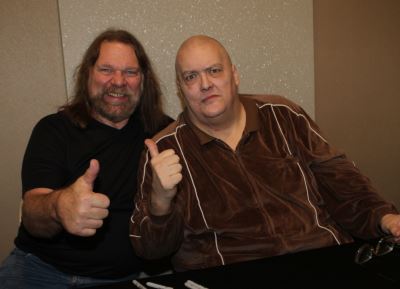
Hacksaw Jim Duggan and King Kong Bundy at a fan fest in 2016. Photo by George Tahinos
His wrestling days done, Pallies slimmed down, dropping 100 pounds or so. He had numerous operations on his feet, five by 2009 alone. The exact cause of his passing on March 4, 2019 is not known. He pulled out of a Modern Vintage Wrestling appearance at the end of January, but tweeted on March 4 that he was going to be at WrestleCon on WrestleMania weekend in David Herro’s booth.
King Kong Bundy was never inducted into the WWF Hall of Fame, likely related to his participation in a lawsuit (since dismissed) against WWE regarding the company’s lack of concern for concussions and neurological issues of its performers.
Funeral information is not known at this time.
KING KONG BUNDY STORIES
- Mar. 22, 2003: Bundy’s big WrestleMania memories
- Dec. 30, 1998: Bundy-mania runs wild in Q&A
